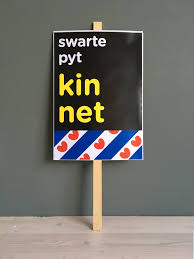Do Images Matter? : Burobraak and Working Against Racism in the Netherlands
- asafford4
- Jul 10, 2018
- 3 min read
Updated: Aug 17, 2019
On the 4thof July, I went to meet with Arjan Braaksma (a graduate of Eindhoven Design Academy, the leading design school in the Netherlands and arguably beyond https://www.designacademy.nl), the force behind Burobraak https://www.burobraak.nl, a social design firm in the Weesperplein area of Amsterdam. Burobraak has done commercial work for Nike, Vernon François Haircare, and is also engaged in social justice work to educate around Zwarte Piet and greater issues of race and equality in the Netherlands.
Zwarte Piet is a complex issue in the Netherlands (here is a brief history of Zwarte Piet by National Geographic https://news.nationalgeographic.com/2017/12/black-pete-christmas-zwarte-piet-dutch/) a fairly liberal society, which has some reckoning to do with its colonial past. Many in the Netherlands have a hard time understanding that the tradition of Zwarte Piet has ramifications beyond their childhood memories in a society that (at times) prides itself on being multicultural.
Amsterdam is proud of being a multicultural city that welcomes diversity including large populations of Dutch people with roots in former colonies such as Surinaam, and Indonesia, as well as a large community of Dutch from Turkey, and from many African nations. They deal with many of the same forms of institutional racism as in the US, but not always in the same ways.
One of the main questions I had for Arjan, was how he became “woke”. As with many white people, it wasn’t any one thing but many things, combined with “double feelings” and a willingness to examine those feelings. Some of events in his life that influenced Arjan were:
· Watching people he knew playing Zwarte Piet as a child
· Living in Iowa as an exchange student, he visited a town original settled by the Dutch. During December, there was a traditional Dutch Sinterklaasavond parade, but sans Zwarte Piet
· Quinsy Garrio (Curaçao-Dutch) and Jerry Afriyie (Ghanaian-Dutch): two Dutch artist and activists who wore T shirts with the words “Zwarte Piet is Racism” to a Sinterklaas parade in Dordrecht in 2011. They were subsequently arrested seemingly without legal justification (https://www.dutchnews.nl/features/2011/11/anti-zwarte_piet_activists_arr/)
· An internship with designer Lance Wyman in NYC (http://www.lancewyman.com)
· The art of Keith Haring http://www.haring.comwho used his art to address political issues in 1980s
· Building prefab housing as a volunteer during two weeks in Kenscoff, Haiti after the devestating 2010 eathquake.
· Studying the history of Black Europe at BESS: Black Europe Summer School, 2015 (http://www.dialogoglobal.com/amsterdam/)
Arjan spoke of a conscious decision to do “important work”: using his graphic design skills to support values of inclusion and equity in the Netherlands. He does work for many clients-commercial, non-profit, social, and cultural. Many specifically seek him out for his dedication to racial justice and inclusion.
Arjan was one of the studios CSW visited during the March 2017 Social Design trip to the Netherlands. He responded to a cold-call email with open arms and enthusiasm. His generosity to CSW's group of high school students from the states was wonderful. Arjan took us to see the Theo Van Gogh monument, and the monument commemorating the end of slavery, both in nearby Oosterpark (images below). Our visit with Burobraak was a great introduction to social design, Dutch culture, and race issues in the Netherlands.
For Burobraak, design is a tool both to communicate ideas, and invoke change. Amsterdam stopped using black face for Zwart Piet seemingly in response to the protests of which Burobraak signs and graphics were part.
In the last blog post, I mentioned valuing both the symbolic and the functional. Zwart Piet shows that images and the symbolic matter (not for the better in this case), and Burobraak embodies the need for the functional to address societal issues head on.
At one point in our discussion, Arjan and I were discussing equity within the design community and the need to see more designers and makers of color both in the Netherlands and US (everywhere really), and that it is important to look at our own micro-cultures of the art and design worlds as well. Where images come from matters.
This is a constant thread in my teaching, and now in this research as well.
Here are a few images of Burobraak’s work, but go to their website for a much more comprehensive view. https://www.burobraak.nl
signs by Burobraak being used in a Zwarte Piet protest
CSW's visit to Burobraak in March of 2017. Jeroen and Arjan of Burobraak, a visit to the memorial to the end of slavery, and a visit to the Theo Van Gogh monument both in Oosterpark
Images from a Tropenmuseum ("tropical" museum, basically an post-colonial ethnographic museum) exhibition examining Zwarte Piet and race issues in the Netherlands.






















Comments